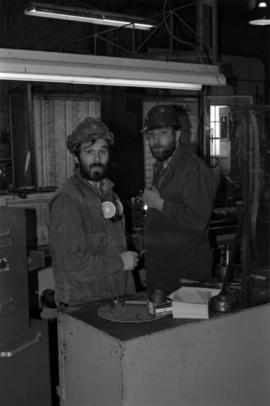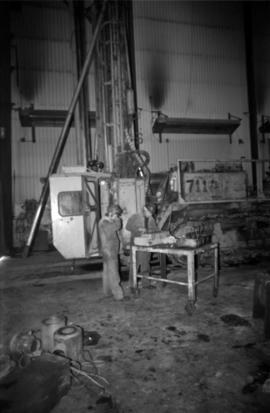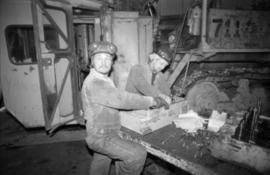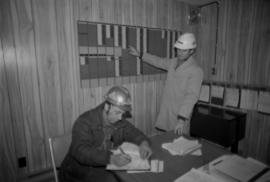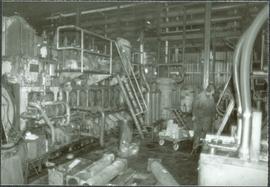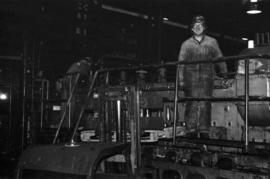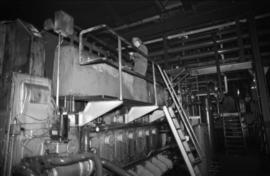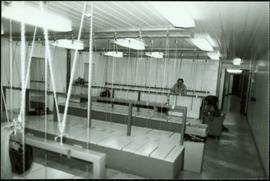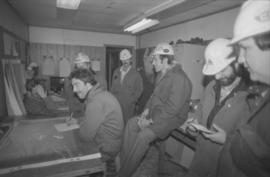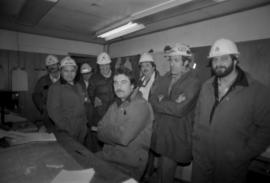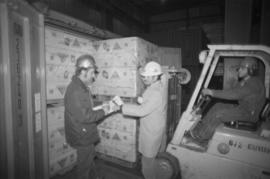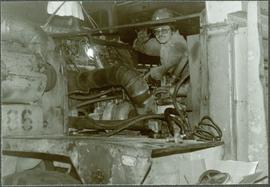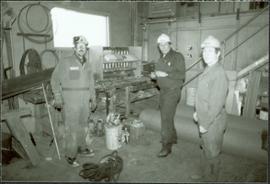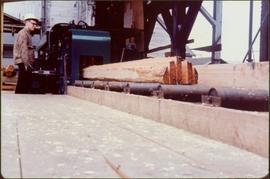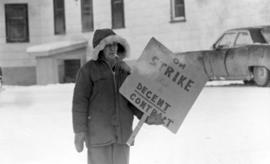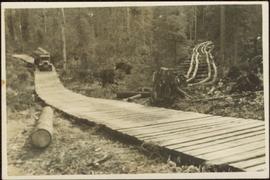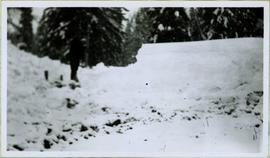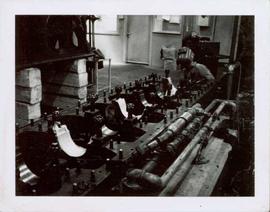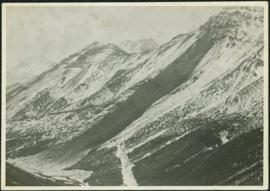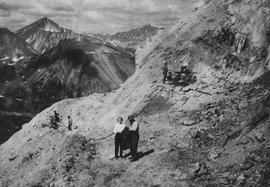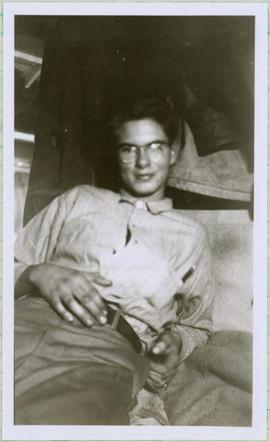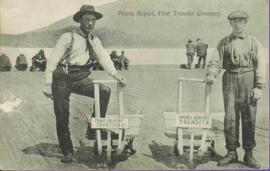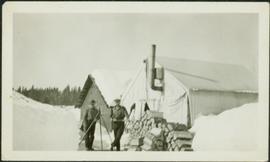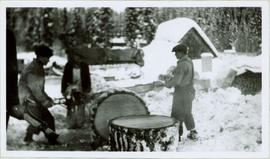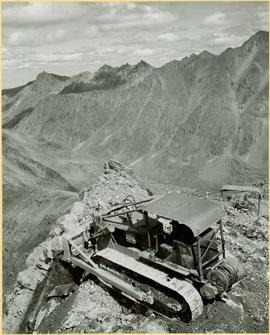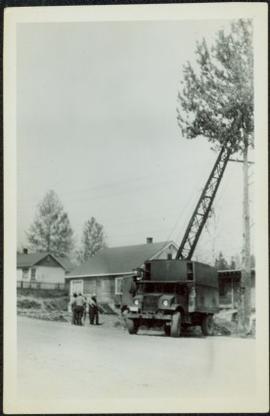Photograph depicts two men wearing coveralls and hard hats in shop area. Wally Cameron stands on right.
Photograph depicts two unidentified men in coveralls and hard hats, working in garage. Blasthole drill stands behind them in midground, walls in background.
Photograph depicts two unidentified men wearing coveralls, hard hats, and headphones, while working at table in garage. Blasthole drill stands behind them in background.
Photograph depicts Chris Tates seated at table with paperwork in left foreground. David Pewsey stands behind on right, pointing to what appears to the Fibre Loading Schedule. Pewsey was supervisor of the Fibre Storage Shed. Both men wear hardhats. Tates believed to be wearing gold nugget Cassiar ring on left hand.
Photograph depicts Ruston Hornsby diesel engines which turned the generators in the power house on the Cassiar plant. Two unidentified men wearing coveralls can be seen in image.
Photograph depicts two unidentified men standing on Ruston Hornsby diesel engine which turned the generators in the power house on the Cassiar plant.
Photograph depicts unidentified man standing on Ruston Hornsby diesel engine which turned the generators in the power house on the Cassiar plant.
Photograph depicts unidentified man standing in change house located at the new Mine Dry building. This change house utilized baskets which could be lowered under hinged covers, while the previous change house used baskets which could be raised by chains.
Photograph depicts group of seven men in the Engineering/Survey building (former location of old mine dry). Photo believed to have been taken during the weekly meeting in which strategies were discussed for open pit operations (blasting, haulroad, ore and waste zones). See item 2000.1.1.3.19.217 for similar photo with individuals identified.
Photograph depicts group of seven men in the Engineering/Survey building (former location of old mine dry). Photo believed to have been taken during the weekly meeting in which strategies were discussed for open pit operations (blasting, haulroad, ore and waste zones). Left to right: Danny Demitri, Roger Borsato, Tim Carew, Don Loverin (behind), Tim Williams (seated), Paul Clarke, Paul McRae.
Photograph depicts group of six men in upper meeting room of Engineering/Survey building (former location of old mine dry). Left to right: Tim Carew, Stefan Dyk, Mike Pennock, Paul Clarke, John Oughtred, [unknown].
Photograph depicts unidentified man operating forklift on right. Pallets of asbestos fibre sit on trailer in background. Two men with clipboard stand in left foreground (David Pewsey on left, Chris Tates on right, see also item 2000.1.1.3.19.212).
Photograph depicts Darren DeCecco wearing coveralls and hard hat while sitting on a Pacific truck. (Pacifics were used to supply water to mine, remove snow, and supplement ore haul by tramline).
Photograph depicts three men wearing coveralls and hard hats in carpenter shop. Left to right: Jason Clark, Alf Guderjahn, Herbert Pichler (shop tool crib man).
Item is a photograph of a worker operating a Chip-n-Saws.
Photograph depicts a worker holding "On Strike for a Decent Contract" sign during the 1970 U.S.W.A. Local 6536 strike at Cassiar.
Handwritten caption beside this photo reads: "Work crew eating in open at 10˚ below zero, evicted from Lunchroom, due to damage to, from falling rock." Men are shown sitting in snow. Various metal materials in foreground, snow-covered mountainside in background. It is believed that power lines are also visible in background.
Fully loaded logging truck driving along a wood plank logging road. Another road under construction is also visible through forest in background.
Handwritten annotation in pencil on verso reads: “Logging - Giscome B.C. Plank truck road - also road under construction showing sills & cribbing."
Winter landscape scene featuring a man cleaning up a wood pile covered with snow (?). Handwritten caption beside this photo reads: "ALL WINTER 1945 1946 Cleaning of the Wood Pile".
Handwritten annotation on recto of photograph: "FOOTING WEST WALL AUG 8/64." Photograph depicts a construction worker near freshly poured cement footings. Building is semi-visible in background on left, tall steel framework behind footings on right. The hard had of a second worker is visible behind footings.
Handwritten annotation on recto of photograph: "WEST WALL FOOTING AUG 8/64." Photograph depicts a construction worker standing on rebar in forms built for cement footings. A front end loader and backhoe tractor can be seen on wood platform above footings. Mountainside in background.
Photograph depicts an unidentified individual wearing a welding helmet, and kneeling behind large bearing cups of one of the Ruston Hornsby diesel engines that turned the generators in the power house on the Cassiar plant. Door, bulletin board, and miscellaneous supplies in background.
Three men can be seen on deck of small boat. Rocky shore in foreground, forest and hills on opposite shore in background.
Handwritten annotations on verso read: "Dad - en route up Nass River on official business. (hence the flag & business suit!)"; "Going up the Nass. Dad (Indian Agent) Cap Barry (Inspect. of Schools) travelling up the Nass River to Aiyansh".
Photograph depicts large swath of dark waste down mountainside to right of valley. The waste dump is believed to be visible at top of swath on right of image. Bench mining visible on the North and South peak in background. Handwritten annotation on recto of photograph: "Oct. 25 / 65 4:25 PM."
One man can be seen on crusher building framework, unidentified equipment and long metal rods in foreground. Power lines, a large tank, and other small buildings are semi-visible on a level in the mountainside just above the crusher building. Sky can be seen in background.
Men can be seen working on site. Crusher building in midground, chutes can be seen crossing the different levels of foundation. Lumber is leaning against excavated dirt wall in foreground, as well as a ladder which reaches up to the base level. Large tank can be seen in top level above building construction. Mountaintop and sky in background.
View showing various levels of foundations. Men can be seen working on site. Vertically protruding planks from framework in foreground. A long building believed to be housing conveyor "B" can be seen in background, as well as the tree-covered valley.
View facing into mountainside and showing various levels of foundations. Men can be seen working on site. Unidentified machinery and pile of long metal rods in foreground.
Men can be seen working on site, building tools and supplies scattered throughout. Handwritten caption beside this photo reads: "View showing various levels of foundations". A chute of some kind extends from high level to men near bottom. Dirt road at site, and tree-covered valley can be seen in background. Construction of a long structure near the edge of the excavation area can be seen in midground; this is believed to be conveyor "B".
Handwritten caption beside this photo reads: "View of Bin and Pan Feeder". Interior view of crusher building. A square, snow-covered object is being lowered by crane into building.
Photograph depicts a man and woman standing on what is believed to be an early mining bench. Two men with air track drill can be seen in background, one man father down on left, mountain range in background. Image slightly distorted due to poor quality of negative.
Photograph depicts two men standing in foreground, hull of unfinished ship in background. Construction supplies and materials throughout.
Image of man seated with shovel in mountainous area, loose asbestos fibre in background. This photograph is believed to be either a double exposure of two images, or a print made from two negatives at once. Photo depicts an unidentified man sitting on the south ridge of the Cassiar ore body, where the crusher and rock reject plant would eventually sit. Valley in background appears to depict the "Footwall Road," which was cut into the mountain from the pit to the crusher plant and became the mine's main haul road.
File consists of clippings and notes relating to unions, trade, and tariffs in Prince George, including material on the International Woodworkers of America Canadian sector, lumber trading with the United States, and United States tariffs on lumber. Includes the following clipped articles from the Prince George Citizen newspaper: "IWA leadership: Controversies of the '40s" (20 May 2000); "American tariffs have long history" (7 Apr. 2001); and "IWA contract first for Interior" (28 Apr. 2001).
Photograph depicts unidentified man with glasses reclining on blanket, coats hanging behind him. Some type of shelving or roofing can be seen in background. Man is wearing pants, belt, and striped shirt with a pencil in the pocket. It is speculated that this man may be Bert Youngstrom, (see items 2005.3.4 & 2005.3.59).
File contains images depicting the underground mine at Cassiar, showing structural damages, repaired damage ground support, and mining and repair processes.
The file contains a photo inventory entitled “Underground Mine Structural Inspection, Rock Mechanics Dept. Foto Documentation” with a complete file inventory linking the picture number to a location, title, and dated film. This photographic documentation was assembled for the purposes of liaising with a underground mining consultant located in South Africa.
- Images document structural ground support including steel cables, support arches, metal mesh, shotcrete, rockbolts, wooden beams.
- Images show ground support damaged through ground movement, but some depict newly installed or repaired support.
- Images depict ventilation ducting that was crushed or torn.
- Mining processes depicted include miners installing a rock breaker, miners paving the adit floor with concrete, miners inspecting a damaged section of mine, miner loading drill or blastholes with ANFO (ammonium nitrate / fuel oil mixture) explosives, and long hole drilling.
- Technical elements of the underground mine depicted include a mining device and ore in a chute (annotated ‘1290 crusher’), the conveyor, ‘LH drill’, ore processing machine annotated ‘1350 breaker’, and an electrical box titled ‘Weighometer’.
- Specific locations shown include ore draw points, ore passes, access drifts, a hatch and door titled “Fuel station 1415”, and a dead end drift with a stack of equipment and an orange cable annotated “1335 access electrical stations”.
This file contains various aspects of the underground mine.
- Photos depicting damage to the underground mine such as fallen rocks, cracked shotcrete, twisted rock bolts and metal mesh, exposed and damaged steel structural frames, and repairs underway.
- Steel cables, chains, support arches, and custom welded rebar frames used in the structural reinforcement of the underground mine.
- Several engineering tests related to the structural damages are depicted.
- Two sets of images show a Porta Power hydraulic tool with a ready rod attached, a hand pump, as well as images of a technician testing the holding power of a rock bolt.
- Set of images documents a technician drilling cores and installing extensometer anchors, as well as grouting the anchors and connecting an extensometer. Technicians are shown inspecting damages with a ruler and rockhammer for scale.
- A set of images showcase the threaded rebar, nuts, and face plates used for rockbolts.
- Utility vehicles, yellow vent ducting, and utility pipes are visible in several images.
- Also include is an image of a man in office space, foggy night scene with a telephone pole, office desk, stack of supplies including concrete, steel cable, and spray paint, and several images of a broken piece of ore and concrete outside the mine portal.
- Several images depict miners working in the bucket of a scoop tram.
- Photos of the stramler feeder breakers, which was used in the underground mine.
- Images of ground support verifications where the deficiency of the exhaust ramp was investigated. This collection has various annotations explaining the broken shotcrete and the wire mesh installed.
- A collection of photographs depicting tunnel shotcrete failures. Each photograph has an accompanied textual annotation.
- Photos of MMD #750 Sizer equipment - assumed used in Underground Mine.
- Photos of pump used in 1335 level, wheel fan for ventilation removed from 1350 level,
- A collection of ground fall event 29 March 1989 - with annotations depicting damage
File consists of a UNBC publication entitled "The Grape Line". File contains newsletters for January 7, 1994; February 25, 1994; April 1, 1994; July 12, 1994
Growing collection of strike ephemera from students, CUPE staff, and faculty members at UNBC. Collection includes picketing signs, strike buttons, photographs, art, and videos from pickets and UNBC Faculty Association events during the 2015 and 2019 strikes, as well as posters and other ephemera from the UNBC Occupiers group.
Two men standing beside wheelbarrows with signs that read: “Prince Rupert Transfer Co.” The men appear to be standing on large dock or boardwalk, water and hills in background. Printed annotation on recto reads: “Prince Rupert First Transfer Company.” Handwritten message in pencil on verso is addressed to “Mr. Gordon Penning 1600 Bld. Barclay Vancouver B.C.” Cancelation date on 1 cent Canadian Stamp is dated “Prince Rupert B.C. July 16, 09”.
Photograph depicts two men standing in snow-cleared area next to firewood pile. Two tent buildings stand behind them, forest trees visible in background. Photograph taken at what is believed to have been a railway construction camp.
Photograph depicts two unidentified men at high elevation on mountain. Trucks and tanks visible in background, hose (possibly of air track drill) in right foreground. Mountain range in background.
Photograph depicts two unidentified men on road or mining bench at high elevation on mountain, valley in background.
Handwritten caption beside this photo reads: "Cutting Fire Wood". Photograph depicts two men on either side of large log using chain saw in wood clearing. A small snow-covered building can be seen in background.
Handwritten caption above this photo reads: "Cutting Fire Wood". Photograph depicts two men on either side of large log using chain saw in wood clearing. A third man is watching them from behind the saw. A wood pile and small snow-covered building can be seen in background, as well as what is believed to be a caterpillar bulldozer.
Photograph depicts unknown men driving bulldozers on edge of mine area at high elevation. Dozers are Internationals, model TD24 (manufactured between 1947 and 1955). Valley and mountain range in background.
Photograph depicts unknown men driving bulldozers on edge of mine area at high elevation. Dozers are Internationals, model TD24 (manufactured between 1947 and 1955). Mountain range in background.
Photograph depicts a group of men standing to right of large truck, houses in in background. Boom of crane visible between truck and houses. Trees and power lines also visible.
Photographs within this file pertain to modes of transportation and transportation routes (including construction, surveying and traveling).
File contains photographs featuring the tramline at Cassiar which ran from the crushing plant at the mountain mine to the plantsite in the valley (a drop of 427 meters). The first ore was originally transported by truck to the plant until the gravity chute was built in 1953. This chute was replaced with the first aerial tramline model in 1956, which was succeeded by the second model in 1975. This file also includes one photo of the original gravity chute, and one photo depicting a tramline worker.
Additionally there is a collection of eighteen photographs of tramline cars that were being surveyed for damage and condition, and another collection of six photographs of tramline study. The results of this study determined that there was variances in load sizes of the buckets caused by extra material falling off the panfeeder.
